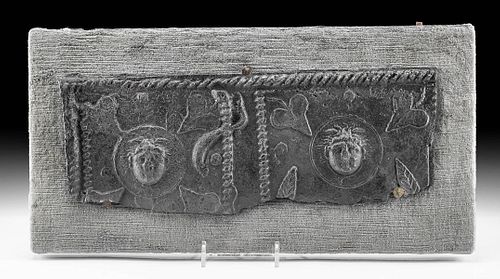Roman Lead Sarcophagus Panel Fragment, ex-Arte
Lot 30
About Seller
Artemis Fine Arts
686 S Taylor Ave, Ste 106
Louisville, CO 80027
United States
Selling antiquities, ancient and ethnographic art online since 1993, Artemis Gallery specializes in Classical Antiquities (Egyptian, Greek, Roman, Near Eastern), Asian, Pre-Columbian, African / Tribal / Oceanographic art. Our extensive inventory includes pottery, stone, metal, wood, glass and textil...Read more
Estimate:
$1,600 - $2,400
Absentee vs Live bid
Two ways to bid:
- Leave a max absentee bid and the platform will bid on your behalf up to your maximum bid during the live auction.
- Bid live during the auction and your bids will be submitted real-time to the auctioneer.
Bid Increments
| Price | Bid Increment |
|---|---|
| $0 | $25 |
| $300 | $50 |
| $1,000 | $100 |
| $2,000 | $250 |
| $5,000 | $500 |
| $10,000 | $1,000 |
| $20,000 | $2,500 |
| $50,000 | $5,000 |
| $100,000 | $10,000 |
| $200,000 | $20,000 |
About Auction
By Artemis Fine Arts
Oct 21, 2021
Set Reminder
2021-10-21 10:00:00
2021-10-21 10:00:00
America/New_York
Bidsquare
Bidsquare : Fall Antiquities & Ethnographic Art Auction
https://www.bidsquare.com/auctions/artemis-gallery/fall-antiquities-ethnographic-art-auction-7725
Ancient art from Egypt, Greece, Italy and the Near East, as well as Asian, Fossils, Pre-Columbian, Native American, African / Tribal / Oceanic, Fine art, and much more! All categories, all price ranges... all legally acquired and guaranteed to be as described or your money back. Artemis Fine Arts info@artemisgallery.com
Ancient art from Egypt, Greece, Italy and the Near East, as well as Asian, Fossils, Pre-Columbian, Native American, African / Tribal / Oceanic, Fine art, and much more! All categories, all price ranges... all legally acquired and guaranteed to be as described or your money back. Artemis Fine Arts info@artemisgallery.com
- Lot Description
Roman, Holy Land / Phoenicia, ca. 2nd to 4th century CE. A remarkable lead sarcophagus panel executed in relief divided into 2 quadrilateral frames with braided borders, each filled with traditional Roman imagery. A gorgoneion or head of a gorgon - a mythological woman with hair of snakes - is featured at the center of each section, both heads surrounded by rondels, as well as 4 leaves that point inwards. The left side of the piece is additionally adorned by a dolphin, whose sinuous body curves along the right border, as though about to dive. This example is replete with symbolism. The leaves refer to actual garlands and flowers used to decorate tombs and altars. The gorgoneion has apotropaic functions as guardians of tombs and were used frequently in ancient homes to avert evil from entering. Size (of panel): 13.3" L x 4.9" H (33.8 cm x 12.4 cm); Size (of board): 15.8" L x 8" H (40.1 cm x 20.3 cm)
The dolphins, meanwhile, remind us of a powerful and popular motif in Roman artwork. The Romans were largely a maritime empire, and the iconography of the sea included dolphins. Romans believed these animals carried souls to the Fortunate Isles, perhaps because they could pass through the air-breathing terrestrial world and into the watery depths that claimed so many Roman sailors' lives. This symbol must have had personal significance for the deceased, who often ordered coffins to be made long before they died. Dolphins can also be a reference to the cult of Bacchus (equivalent to the Greek god Dionysus).
Prior to the 2nd century, Romans cremated their dead; around that time, they became inspired by the Greek and Etruscan practice of using sarcophagi, and they began to make coffins. This trend spread rapidly throughout the Roman Empire and between social stratums. While those of nobility would commission marble sarcophagi, the middle class would commission lead sarcophagi, such as this one. Lead sarcophagi were only made in Phoenicia, or the Eastern part of the empire, but were shipped west due to popularity.
Provenance: ex-Arte Primitivo, New York, USA, auction #100, December 15th, 2020, lot 461; ex-Long Island, New York, USA collection; ex-Aphrodite Ancient Art, New York City, New York, USA
All items legal to buy/sell under U.S. Statute covering cultural patrimony Code 2600, CHAPTER 14, and are guaranteed to be as described or your money back.
A Certificate of Authenticity will accompany all winning bids.
PLEASE NOTE: Due to recent increases of shipments being seized by Australian & German customs (even for items with pre-UNESCO provenance), we will no longer ship most antiquities and ancient Chinese art to Australia & Germany. For categories of items that are acceptable to ship to Australia or Germany, please contact us directly or work with your local customs brokerage firm.
Display stands not described as included/custom in the item description are for photography purposes only and will not be included with the item upon shipping.
#167678Fragment of a larger piece. Expected softening of detail with nicks and abrasions throughout, all commensurate with age. Otherwise, very nice with lovely patina. Mounted on an old cloth covered board.Condition
- Shipping Info
-
All shipping is handled in-house for your convenience. Your invoice from Artemis Gallery will include shipping calculation instructions. If in doubt, please inquire BEFORE bidding for estimated shipping costs for individual items.
-
- Buyer's Premium



 EUR
EUR CAD
CAD AUD
AUD GBP
GBP MXN
MXN HKD
HKD CNY
CNY MYR
MYR SEK
SEK SGD
SGD CHF
CHF THB
THB













